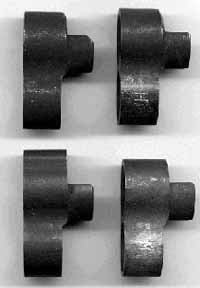M1 Rifle Gas Cylinder Locks ©
For those who are familiar with the M1 rifle, but not familiar with the gas cylinder lock, it is the figure eight piece that screws onto the barrel. It prevents the gas cylinder from moving during recoil and eventually ending up down range. It abuts the gas cylinder and works in conjunction with the cylinder and lock screw to insure proper passage of gas to the operating rod, which makes the rifle semi-automatic.
There have some conflicting facts about the various designed locks. The facts as I know them show there to be four locks, numerically, as follows:

Top Left- WWII Beveled
Ordnance Part # 6147426 - WWII design, beveled, not hardened.
Top Right -“H” Beveled
Ordnance Part # 7162247 - Same configuration as above, marked with “H” for hardened. Drawing date puts engineering circa mid 1945, packed with M7A1 launchers per post war reports.
Bottom Left- High Hump
Ordnance Part # 7265871 - High Hump lock, original engineered 1/4/1951, hump limits rear movement of M7A2 Grenade Launcher during rearward movement, preventing damage to lock screw’s valve. Packed with M7A2’s, and all M7A3’s except the last contract and part of one other contract, which provided both the flat edge and the high hump. Lock is hardened.
Bottom Right- “M” Flat Edge
Ordnance Part # 7265959 - Flat Edge lock, marked with M for magna flux or magnetic particle test, to check for cracks. (Hardened) Packed in last contract for M7A3 Grenade Launcher Mfg’d by Acme Machine, Hingham, Mass., May of 1956, and part of Sun Ray's contract.
The reason for the various types of locks is a direct result of launching rifle grenades off of the M1. The first lock, the WWII version, was soft. Repeated launching of heavy projectiles would peen the lock, sometimes to the point that the M7 would actually climb up the bevel and get stuck.. Ordnance reports stated the need for a hardened lock to be developed and issued with the T95 (M7A1) launcher. The unanswered question was always: Was it the “H” marked beveled type? Yes, it was.
To summarize:
1- It was the “H” marked lock that was packed with the M7A1, not the flat edge. The drawing number of the flat edge is later than the high hump, which first appeared in 1952. Thus the flat edge was probably not in existence in 1945.
2- The flat edge is probably an alternative design to the high hump and although it carries a later drawing number, it probably is not later. A look at the original drawings will show the original engineering date, unfortunately I do not have access to the flat edge lock’s drawing.
3- The flat edge lock was the last lock produced under government contract, that being in 1962. The launching of projectiles from rifles was deemed less important upon adoption of the M79 Grenade Launcher, the LAW rocket system, and the hand held rocket propelled pyrotechnic signals (pop ups). These reasons are probably why the high hump lock was not made after 1956.
4- Conclusion: The flat edge lock might have been a modification to the “H” lock, which would be very simply flattening the bevel. The flat edge lock was originally engineered for use with the M7A1 Grenade Launcher to provide a flat surface as the launcher moved to the rear. Upon adoption of the M7A2 the production of the flat edge ceased until 1962.
All inquiries regarding this research project must be by email.
To contact me..... This email address is being protected from spambots. You need JavaScript enabled to view it.">CLICK HERE

